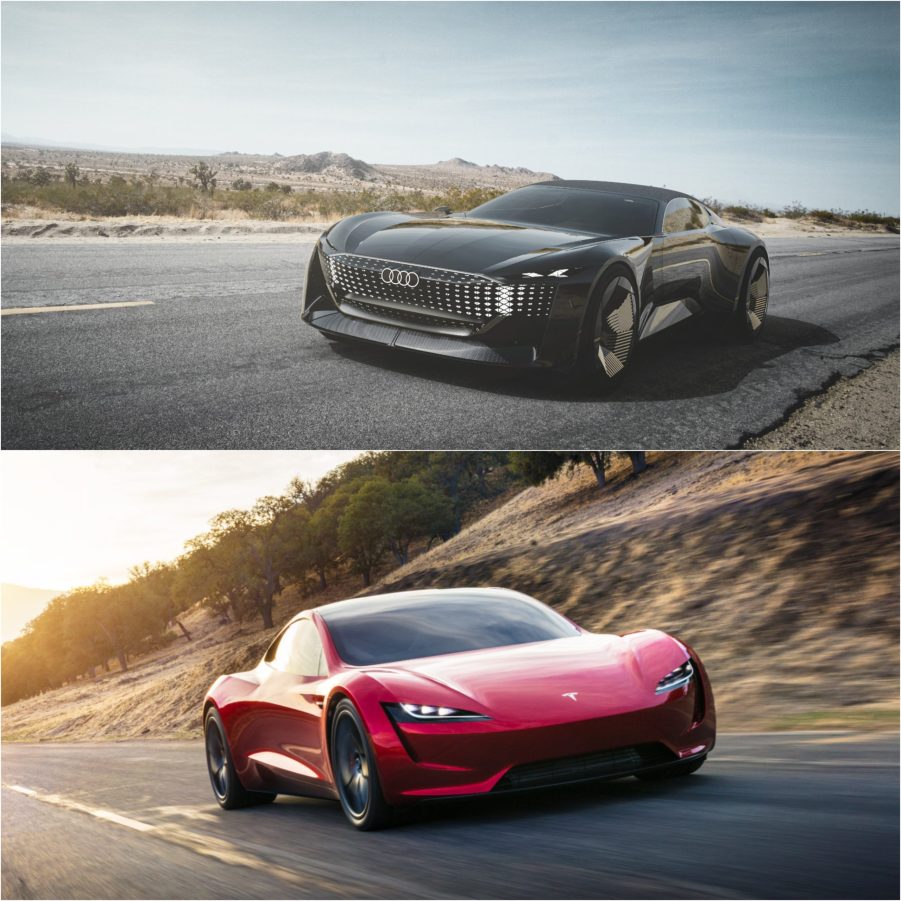
Comparing the Audi Skysphere Concept to the Tesla Roadster
The Tesla Roadster has been talked up for months, with its incredibly 0-60 time, ultimate prestige, and electric car capabilities. But Audi just debuted the Skysphere electric concept car that makes the Tesla Roadster look basic. It’s high society at its highest, with brand new luxury features never seen on a car. Though perhaps this isn’t a fair comparison, as one of them is a fully-fledged concept, while the other will be a production car… eventually.
The Audi Skyphere Concept is twice the electric car than theTesla Roadster
We aren’t saying that to sound dramatic either, the Audi Sky Sphere concept is literally two cars in one. Of all the vaporware technologies the Sky Sphere introduced, its ability to transform from a long-wheelbase grand tourer to an invigorating sports car is the most incredible. In the GT position, the Skysphere is 17 feet long, a decision made that pays homage to the classic Horch 853 convertible (which was 17.1 feet). But by putting the car in sport mode, the body contracts to 16.2 feet to make a shorter wheelbase that improves overall handling.
The Tesla Roadster is just shy of 14 feet, which in theory means it’d handle better. A shorter wheelbase allows for a nippier car. But that smaller body doesn’t equal less weight, as the Roadster weighs 4,409 lbs while the Skysphere weighs 3,968. So while the Roadster may, in theory, handle better, the lightweight would make the Skysphere a faster car. Right?
The speed, range, and specs of the Tesla Roadster and Audi Skysphere Concept

One would come to the conclusion that the lighter, longer Audi would be faster. But in actuality, the Tesla takes the cake. The Roadster is powered by a 1000 kW electric motor, equal to somewhere around 1,300 horsepower. Meanwhile, the Skysphere only packs 465 kW or 623 horsepower. So sure, the Roadster is 500 lbs heavier, but it’s also twice as powerful.
And that electric motor can get the Roadster from 0-60 in 1.9 seconds (or 1.1 seconds with the SpaceX Package), whereas the Skysphere takes four seconds to make the dash (“if required,” according to Audi). So now you’re thinking, if the Roadster’s engine uses so much more juice, it should be less economical, right? Wrong again, actually. The Skysphere has an estimated range of 310 miles, whereas the Roadster doubles that, managing 620 miles per charge.
So now you’re thinking “alright, being able to shrink and expand is a neat party trick. But can the Audi Skysphere do anything better than the Tesla Roadster?” Well, I’m glad you asked. The Audi Skysphere boasts one technology the Roadster couldn’t dream of: Level 4 Autonomous Driving.
The Audi Skysphere Concept is a genuine self driving car

The Roadster will have Autopilot built-in, Tesla’s semi-autonomous driving mode. But the Audi Skysphere has Level 4 autonomy, allowing the driver to take their hands off the wheel and mind off the road. In fact, when in the autonomous GT mode, the car doesn’t just extend to give it a bigger presence. The entire interior, from the pedals to the dashboard and steering wheel all tuck away. The cabin transforms into an immense lounge for two people to enjoy.
That said, the Roadster does beat out the Skysphere in terms of seating, with room for four passengers. But in terms of luxury features, that’s about all the Tesla has over the Audi. The Skysphere has a touchscreen spanning the length of the cabin, that passengers can enjoy as the car drives itself. And it can link to exclusive events and concerts, granting Audi owners brand new experiences.
But all the technologies Audi threw into this concept won’t make it into production electric cars, at least not all at once. Self-driving still has some evolving to do, and I doubt production cars will expand and condense like the Skysphere anytime soon. So for now, even though the Tesla Roadster is still unavailable, it’s the most realistic of the two.


